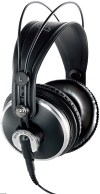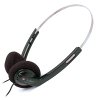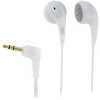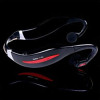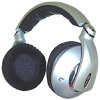Want to get the most out of your sound card, but can't really pump up the volume because of dubious neighbors? Feel like doing the same at work or any other public space that may put some limitations on those loud sound waves? What you need is a pair of good headphones to let you enjoy quality sounds without disturbing the others.
The ear gear Headphones are actually a pair of transducers that receive an electrical signal from a sound source and use speakers than can be attached to the human ears in order to convert the signal into audible sound waves. When referring to telecommunications, headsets usually describe a combination of headphones and microphone used for two-way communication methods, such as cell phone hands-free devices or headsets that could be used with Instant Messaging/VoIP programs.
The first headphones were quite rudimentary and date back to the beginnings of the history of the telephone and the radio. Beyerdynamic, a German company, is officially considered to be the inventor of headphone devices. It was in the late 1930s when the company began to market headphones to the public.
For consumers, there is a wide array of products to which headphones may be connected: Walkman-like devices, cell phones, CD players, Minidisc players, digital MP3 players, and last, but not least, the PC. In addition to the usual wired connection, headphones may also be cordless, using radio (digital Bluetooth, Wi-Fi or infrared) waves to receive signals from a base unit.
When talking about the professional sector, headphones are used in live-representations by DJs and sound engineers in order to monitor sound channels independently from what the public hears through the immense speaker systems. Audio special effects can also be previewed this way. In radio-broadcasting studios, disk jockeys usually use a pair of headphones when talking in the microphone while the speakers are turned off, for reduced feedback and monitoring of their own voice. Likewise, in music-production studios, musicians and singers use headphones to play along a backing track. These professional headphones tend to be of better quality than 'normal' headphones.
Returning to wired connectors, the two common solutions are the 1/4" and 3.5 mm plugs. Headphones designed for home stereo systems and recording studios use the older 1/4" connector. In 1979, Sony introduced the 3.5mm connector, adapting the older monophonic 3.5 mm connector for use with its new line of Walkman stereo devices. The 3.5 mm connector is more popular nowadays due to a remarkable boom of portable music devices. In other words, the professional music world uses only the ?" connector, while the consumer market supports the 3.5 mm format.
Listen closely Apart from the fact that you can privately listen to whatever you like without disturbing the others, headphones can also provide a level of sound quality that could only be matched by high-end expensive speaker systems. Take for example the bass frequencies. Quality headphones, with a good seal to the ear can have an extremely flat low-frequency response down to 20 Hz within 3dB. Headphones can also be useful for videogames that use 3D positional audio, allowing players to better judge the position of an offscreen sound (such as the footsteps of an opponent).
However, these devices are not all milk and honey, as they can affect the human ear in different damaging ways. Headphones that provide a sufficiently high volume level can cause temporary or permanent hearing impairment or deafness due to an effect called masking. The headphone volume has to somehow cancel the background noise, especially in excessively loud places such as subway stations, airplanes, and large crowds. This leads to the disappearance of the normal pain associated with higher levels of volumes, but extended periods of loud sound signals are nonetheless extremely damaging.
The first attempts at protecting people's years with additional circuitry or light signals were quickly dismissed by the consumers. In recent years, interest has once again focused on protecting hearing, and companies have responded. Sony implemented the AVLS feature, which corrects differences in track volumes as they are being played, while Apple's Sound Check normalizes the peak volumes of selected tracks in iTunes. Moreover, the French government has imposed a limit on all music players sold in the country - they must not be capable of producing more than 100 dbA (the threshold of hearing damage during extended listening is 80 dB, and the threshold of pain, or of immediate hearing loss, is 130 dB). Still, not all consumers agree to these types of infringements. Other risks arise from the reduced awareness of external sounds.
Headphones family portrait Here are the most common headphone types:
1. Full Size Headphones - the largest among the family. This type of headphones is generally required to deliver impressive sound performance and isolation but they are not designed to be too portable.
2. Portable Headphones - as opposed to the full size ones, portable headphones are compact and lightweight. However, lightweight doesn't mean they can't deliver high overall quality sounds. Many portable headphones integrate electronics that provide impressive sound reproduction just like their full size relatives. Because of the lightweight structure, some people prefer to hang their headphones around their neck, pumping the volume all the way up so that they can still hear the music. This allows the wearer to listen to other things while still enjoying their favorite tunes.
3. Earbud Headphones - this type eliminates the usual headband for ultra-lightweight comfort. You can use these while working out or jogging. Earbuds are one of the most popular types of headphones, favored by the portable MP3 players market.
4. Streetwise Headphones - these are especially useful when walking your way through the city. Just like the earbud type, streetwise headphones eliminate the conventional headband that goes over the head and may feature behind-the-head headbands, or a clip that fits around the ear. They are light and don't interfere with your hair or hat.
5. Side-Firing Behind-the-Head Headphones - these are special earbuds that are designed to direct the sound right into the ear canal. The result can mean a better fit, with improved bass performance.
6. Wireless Headphones - as mentioned before, these eliminate the connecting wire altogether. However, they still require a transmitter that must be connected to the sound source. Wireless headphones are available in different technological platforms, including RF, infrared, Bluetooth or WiFi.
7. Noise Cancellation Headphones - are good at reducing surrounding, or ambient noise. There are two types of noise cancellation techniques. Active noise cancellation utilizes a powered circuit and miniature microphones to create an "anti-wave" that cancels the surrounding noise at the ear proximity, while passive noise cancellation utilizes the mechanical design and fit of the headphone to eliminate the ambient noise.

Besides this classification, one could find different sound drives and backing types with the above-mentioned models. Thus, a pair of headphones may integrate:
a) Dynamic drives - the most common type used in present-day headphones. The operating principle of this model is similar to the dynamic design found in loudspeakers. It consists of a stationary magnetic element affixed to the frame of the headphone which sets up a static magnetic field. Modern dynamic headphone drivers were derived from dynamic microphone capsules.
b) Electrostatic drives - more expensive than dynamic, and relatively rare. A special amplifier is required to amplify the signal to oscillate the membrane, which moreover requires electrical potentials in the range of 100 to 1000 Volts.
c) Balanced Armature drives - usually used only in earbuds (due to their diminutive size and low impedance). They are generally limited at the extremes of the hearing spectrum (50 hertz) and require a seal more than other types of drivers to deliver their full potential. Some canalphones may integrate an armature driver (for high frequencies) and a small dynamic driver (for low frequencies). High-level solutions may include a double or even a triple balanced armature to provide quality output. This is also the case of headphones that simulate surround sound. 5.1 headphones include as much as five separate earbud-like drives for mid and high frequencies and one dynamic drive for low frequencies in each headphone cup.
Backing designs are of two types:
- Open (or "open air") headphones have an open grille on the back of the driver, exposing the driver to the outside, and allowing the soundwaves to propagate away from the ear freely. It is clear that this type does not provide a good isolation from outside sounds. The open quality further leads to the fact that sound can be easily heard by others in the vicinity of the user. To compensate these shortcomings, these models have a more expansive soundstage (due to the lack of resonance) and more tightly controlled sound reproduction.
- Closed headphones have a sealed backing, which attenuates propagating sound waves. As a result, listeners away from the headphones can scarcely hear the headphones output. Moreover, environmental noise is attenuated due to the sealed quality and at least 10dB may be canceled from the overall outside sounds. Because of this, they are used to exclude external sounds in sound recording studios. Unfortunately, they suffer from harmonic distortions and resonating bass.That would be all that you should know about headphones. I told you this week is going to be dedicated to network devices and with the next article, we are going to start analyzing this.

 14 DAY TRIAL //
14 DAY TRIAL // 
